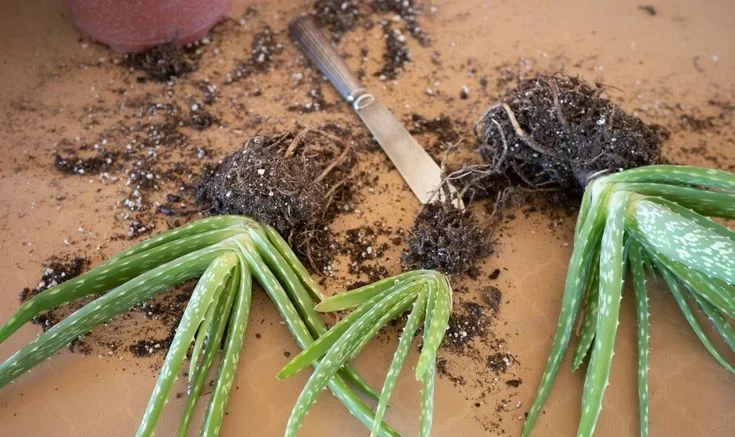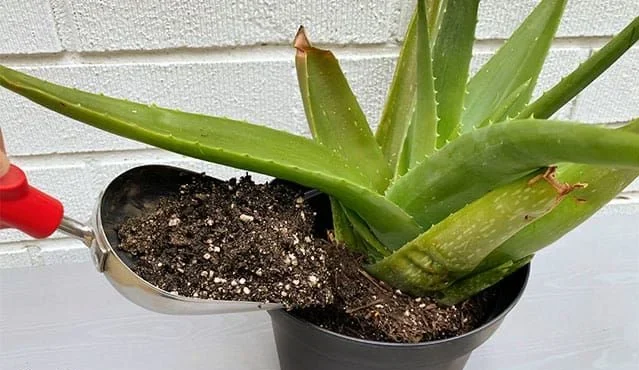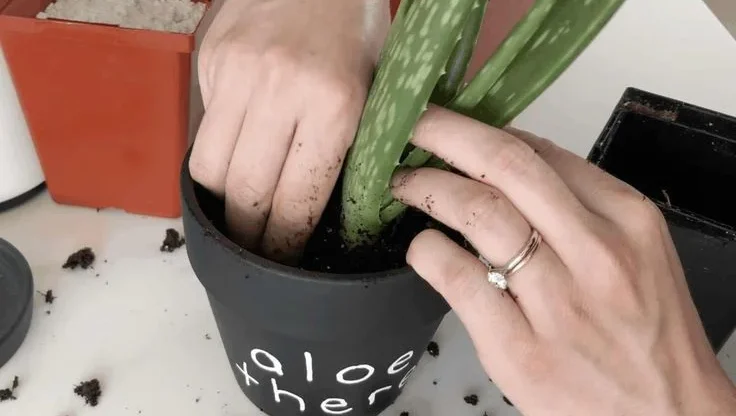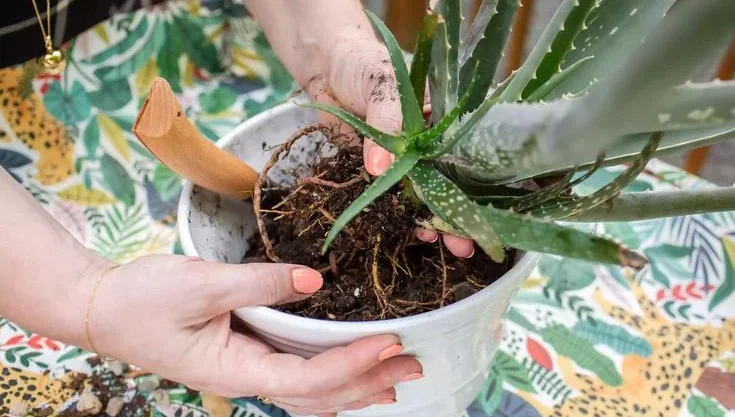Repotting aloe vera plant is one of the most important steps in keeping your succulent thriving for years. As aloe vera grows, its roots often become crowded, and the soil loses nutrients. Therefore, learning the right time and method for repotting aloe vera plant ensures healthier leaves, stronger roots, and improved medicinal benefits.
In this guide, you will discover everything you need to know about when and how to repot aloe vera, from soil selection to aftercare tips.
Why Repotting Aloe Vera Plant is Important
Repotting aloe vera plant is not just about giving it a new pot. Instead, it is a vital part of its long-term care. Aloe vera thrives in well-draining soil, but over time, the soil can become compacted and depleted of nutrients.
Additionally, as the plant matures, the roots outgrow the pot, making it harder for the aloe to absorb water and nutrients. Consequently, repotting gives the plant more space to grow while improving airflow around its roots.
Moreover, repotting helps prevent root rot a common problem when aloe vera sits in soggy soil for too long. By refreshing the soil and upgrading to a proper container, you set the foundation for a healthier plant.
When Should You Repot Aloe Vera Plant?

Knowing the right time is key to repotting aloe vera plant successfully. While aloe vera does not need frequent repotting, certain signs indicate it’s time:
- Roots outgrowing the pot: If you see roots poking out of the drainage holes.
- Soil issues: Soil that stays wet for too long or looks depleted.
- Overcrowded offsets: Small baby plants, known as “pups,” growing around the base.
- Top-heavy growth: When the plant leans or the pot tips over.
Ideally, aloe vera should be repotted every 2–3 years, or sooner if these signs appear. Spring and early summer are the best times since aloe vera grows actively during warmer months.
Choosing the Right Pot for Repotting Aloe Vera
The pot you choose plays a significant role in the plant’s survival. Clay or terracotta pots are highly recommended because they allow moisture to evaporate, reducing the risk of root rot.
When selecting a size, always pick a pot that is one size larger than the current one. This ensures enough room for growth without leaving excessive space that holds water.
Also, ensure the pot has proper drainage holes at the bottom. Without drainage, aloe vera may suffer from overwatering problems.
Best Soil Mix for Aloe Vera

Soil quality directly affects aloe vera’s growth after repotting. Standard garden soil is too heavy and retains water, which can harm succulents. Instead, use a well-draining cactus or succulent mix.
You can also create your own soil blend:
- 2 parts potting soil
- 1 part sand or perlite
- 1 part pumice or small gravel
This combination ensures proper drainage while retaining just enough moisture for aloe vera’s roots.
For more in-depth soil mix ideas, you can check The Spruce guide on succulent soil.
Step-by-Step Guide to Repotting Aloe Vera Plant
Repotting aloe vera plant may seem challenging, but following a simple step-by-step guide ensures success. Start by gently removing the aloe vera from its old container and inspecting the roots for damage. Next, separate any small pups growing around the base so they can be replanted individually.
Next, separate any small pups growing around the base so they can be replanted individually.
After trimming unhealthy roots, prepare a new pot with fresh, well-draining succulent soil. Place the aloe vera in the center, fill in the gaps with soil, and lightly press around the base to stabilize it. For more tips on choosing the right pot and soil for larger plants, check out our guide on large aloe vera plants here. Finally, wait about a week before watering to help the roots adjust. Following these steps ensures your aloe vera thrives in its new home.
By following these steps carefully, you create the best environment for your aloe vera to thrive and grow stronger.
Step 1: Remove the Plant from Its Old Pot
Gently loosen the soil around the roots and tilt the pot to remove the aloe vera. If it feels stuck, tap the sides of the pot to release it. Be careful not to damage the roots.
Step 2: Separate Offsets (Pups)
If there are baby plants around the base, carefully separate them. These offsets can be planted in their own pots to grow new aloe vera plants.
Step 3: Trim Damaged Roots
Check the roots and remove any that appear mushy, rotten, or too dry. Healthy roots are white or light brown.
Step 4: Prepare the New Pot
Fill the bottom of the new pot with a layer of fresh succulent soil. This provides a stable foundation for the plant.
Step 5: Place the Aloe Vera
Position the aloe vera in the center of the pot and fill the remaining space with soil. Press lightly around the base to secure the plant.
Step 6: Water Sparingly
After repotting, wait at least 5–7 days before watering. This allows the roots to settle and reduces the risk of rot.
Aftercare Tips for Repotted Aloe Vera

Once you complete repotting aloe vera plant, proper aftercare is crucial.
- Light: Place it in bright, indirect sunlight. Direct harsh light may stress freshly repotted roots.
- Watering: Resume a normal watering schedule after a week. Typically, water every 2–3 weeks, depending on the climate.
- Fertilizer: Use a diluted succulent fertilizer once during the growing season. Avoid over-fertilizing.
- Observation: Watch for signs of stress, such as drooping leaves or yellowing. These may indicate overwatering or poor drainage.
Common Mistakes to Avoid
While repotting aloe vera plant is simple, many beginners make common mistakes:
- Choosing pots without drainage holes.
- Overwatering immediately after repotting.
- Using regular garden soil instead of well-draining soil.
- Repotting during the dormant winter season.
Avoiding these mistakes ensures your aloe vera thrives in its new environment.
FAQs
How often should I repot aloe vera?
Typically every 2–3 years, or when the roots outgrow the pot.
Can I repot aloe vera in winter?
It is not recommended. The best time is spring or summer when aloe is actively growing.
Should I water aloe vera right after repotting?
No. Wait about a week before watering to allow the roots to heal.
Can I use regular soil for aloe vera?
No. Regular soil retains too much moisture. Always use a succulent or cactus mix.
Repotting Aloe Vera Plant: Conclusion
Repotting an aloe vera plant is a vital part of maintaining its long-term health. By choosing the right pot, soil, and timing, you can help your aloe thrive and continue providing its natural benefits. Additionally, understanding its sunlight needs is crucial for optimal growth; you can learn more about this in our guide on do aloe plants need sun.
From separating pups to giving the roots space to grow, each step ensures your plant stays strong. With proper aftercare, your aloe vera will not only survive but also flourish in its new pot.
Whether you are repotting for the first time or refreshing your plant’s home after years, these professional tips will guide you toward success. Ultimately, a well-cared-for aloe vera rewards you with vibrant growth and countless uses in skincare, wellness, and home décor.


















